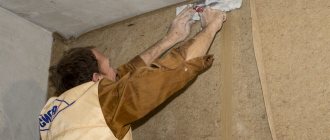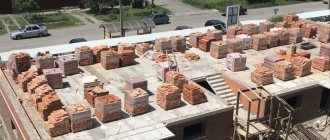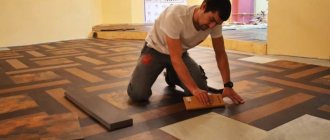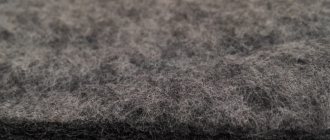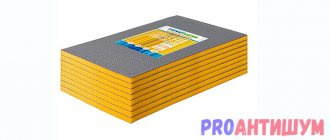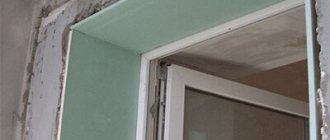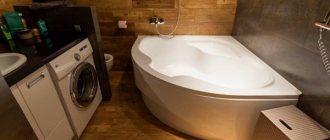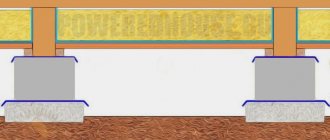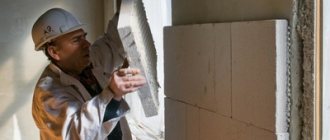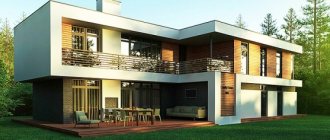“Do you want me to kill the neighbors who are disturbing my sleep?” — Zemfira once suggested in a minor song motif from the stage. Metaphor is a metaphor, but probably each of us has had similar thoughts at least once in our lives: living in apartment buildings has its own “romance.” However, there is a good and completely legal way to rid yourself of overly loud neighbors who happily share their musical tastes at night - this is to soundproof the walls in the apartment. Of course, it will not eliminate absolutely all sounds coming from outside into your apartment, but it is a fact that it will make your stay much more comfortable. What material is best to use for sound insulation? What are the installation features? Read about all this and more below.
- Why is this necessary;
- The best modern materials;
- Price comparison. Table;
- Preparing the wall for installation;
- Features of frame installation;
- Frameless installation and its nuances;
- Conclusion.
Why is this necessary?
There are different noises: average, strong and not very much. But in different situations we are forced to react to them with our auditory receptors, distracted from our daily affairs. Does this violate our personal space? Of course, and therefore not doing anything to protect him is the same as not respecting yourself. Soundproofing walls is your decisive answer to music lover neighbors through the wall, loud repair work in the morning, a running washing machine or a TV broadcasting to the entire entrance.
- counteraction to all 4 types of noise waves: airborne ( conversations, music
), acoustic (
echo
), shock (
repair work
), structural (
elevator noise at the entrance
); - limiting the noise flow emanating from your apartment;
- additional insulation;
- comfort and harmony at any time of the day.
Pay attention to the second point
- thanks to soundproofing wall surfaces, you not only limit the sound flow entering your apartment, but also stop the spread of noise waves that come from you. Of course, it’s hard to believe (sarcasm!), but sometimes we ourselves become unwitting sources of annoying noise. Therefore, making sure that this does not happen is a direct sequence on your part, perfectly illustrating integrity and honesty.
Video text
+7(495)14-27-46 PLASTERING AND SOUNDPROOFING WALLS IN 6 minutes Mechanized Plastering in 7 minutes Full cycle https://www.youtube.com/watch?v=iK2jQ. POLITE BUILDER. MOSCOW Rough repairs WE OFFER Rough repairs (the most important) of your apartment, house or commercial property.
WE ARE UNIQUE IN THIS We take responsibility for the most important stage of repair, all work is carried out with the conclusion of a contract and the provision of a guarantee.
AND WE DO THE SAME We provide services in certain areas: mechanized wall plastering, semi-dry floor screed, plumbing and electrical services.
Polite builder, apartment soundproofing, sound insulation under plaster, installation of interior doors, plaster and sound insulation, ceiling sound insulation, electrical installation in the apartment, sound insulation of the apartment floor, electrical installation, sound insulation under plaster, plaster and sound insulation, ceiling sound insulation, electrical installation in the apartment, sound insulation of the apartment floor, polite builder Moscow.
Choose reliable craftsmen without intermediaries and save up to 40%!
- Fill out the application
- Receive offers with prices from masters
- Select performers by price and reviews
Order sound insulation for plaster
Our website will help you quickly find a private craftsman or team to perform any repair work. Just place your request, and within a few minutes you will receive offers with prices from available craftsmen ready to fulfill your order.
Feedback on the task
Great team, they did everything on time and carefully. Soundproofing the front door + minor improvements. I recommend!!
Feedback on the task
Afig did the plastering of the walls all smoothly and efficiently, no comments.
Feedback on the task
Everything was done efficiently and on time!
Feedback on the task
The master did everything very well. The walls are now smooth, the openings are decorated. I highly recommend the master
Feedback on the task
They did it very quickly and efficiently. The walls are smooth, the angles are strictly 90 degrees, there is a good base for the tiles. I am pleased with the results of our cooperation.
Feedback on the task
Dilshod is an honest master! He did the plastering perfectly, everything that was specified!! The team is high-speed, well-coordinated and professional. I recommend:)
Price comparison. Table
In order to decide on a budget, it will be useful to carefully study the market. We decided to save your time and listed prices for popular soundproofing materials in the table below. The most common options are mentioned, but nothing stops you, of course, from going deeper into market monitoring yourself and finding something truly unique.
| Name of soundproofing material | Price |
| Schumanet-ECO acoustic plate | from 225 rubles per 1 sq.m. |
| TECSOUND FT-75 soundproofing tape | from 1700 rubles per 1 sq. m |
| TECSOUND SY 70 self-adhesive soundproofing membrane | from 1400 rubles per 1 sq. m |
| Wicanders Dekwall Melville cork panel | from 900 rubles per 1 sq. m |
| TechnoNikol Rocklight 50 mineral wool | from 500 rubles per 1 sq. m |
| ROCKWOOL SANDWICH BUTTS WITH SOUNDPROOF PANEL | from 4500 rubles per 1 cubic meter. m. |
Partitions made of aerated concrete or foam concrete
These materials are similar in composition and have a porous structure, which reduces weight and increases their thermal insulation properties. They are supplied in the form of large blocks and have good geometry, which simplifies their installation. They can be easily processed - drilled, cut, so it is easy to lay channels for electrical networks and make holes for sockets in them. They are resistant to moisture, environmentally friendly and durable enough to withstand the weight of heavy hanging furniture or equipment.
Of course, when installing partitions made of aerated concrete or foam concrete, it will not be possible to avoid “dirty” processes associated with the preparation and application of adhesive mixtures. It is also better to involve trusted specialists in installation, although compared to piece bricks, the work is not as complicated and takes less time.
Preparing the wall for installation
Experts know well: any installation begins with careful preparation of the surface. Skip this stage - and then all the work will go down the drain due to existing cracks, uneven joints and other small issues that sometimes affect the result no less than the type of material itself and its immediate characteristics.
- clean the walls from dirt, dust and old material;
- seal all cracks with putty;
- Treat the entry and exit points of pipes and other utilities with acoustic sealant;
- Before moving on to the next stage of repair work, treat the entire wall with a deep penetration primer - this will strengthen adhesion with the next material, as well as prevent the appearance of any manifestations of pathogenic flora (for more details, see the article: “Mold on the walls in an apartment: all ways to solve the problem”).
How does sound insulation work?
Sound insulation in the house is carried out by installing a multi-layer structure consisting of sound-absorbing materials of various structures and densities. The more multi-layered the device, the better it will protect against airborne and impact noise. Some materials provide sound absorption, others are used for sound insulation.
This device is wall mounted using a metal frame or glued directly to the wall. The entire structure is covered with finishing materials, the most common of which is plasterboard. After installing all the elements of the soundproofing structure, the wall can be covered with plaster or wallpaper.
Features of frame installation
The main feature of the frame method of soundproofing walls is already stated in the name of the operation - it is necessary to build a frame from wooden beams or metal profiles, to which the rest of the material is later attached. It seems that this information alone is enough to understand: for very modest rooms this method is undesirable. The fact is that the frame with the subsequent fixation of soundproofing material risks seriously reducing the space, up to 12 centimeters. For spacious apartments this is a drop in the ocean, but for Khrushchev-era apartments that are not spoiled by extra square meters, this is a serious figure.
Mineral wool
is installed from the materials mentioned above with the obligatory installation of a frame . It is recommended to use it in conjunction with a thin soundproofing membrane and plasterboard construction. This allows you to achieve optimal sound insulation in the apartment and solve the problem brilliantly.
Stages
- the base wall is marked;
- a guide metal profile is mounted;
- a rack-mount metal profile is installed;
- installed profiles are covered with polystyrene tape to improve noise reduction performance and avoid contact of the metal part of the profile with the wall;
- cut pieces of mineral wool are inserted between the metal profiles;
- the cotton wool is secured with wide-headed anchors;
- all existing joints are carefully puttied;
- installation of a profile for the ventilation gap between the mineral wool and the plasterboard sheet is carried out;
- gypsum board sheets are fixed.
. It must be glued immediately after installation. This combination significantly increases sound insulation characteristics, but will require you to invest significantly more in repairs.
Detailed installation instructions on the walls in the apartment in the video.
Of course, instead of profiles, you can use ordinary wooden slats. But the wood used must be well treated with an antiseptic and is much less durable than ready-made profiles sold in hardware stores.
Paper
The paper backing for the wallpaper is made from wood, so it is absolutely safe for people. It is indispensable in cases where it is impossible to remove old finishes from the walls. It has low strength characteristics and does not allow you to hide wall defects.
It comes in two types:
- For heavy wallpaper. The paper backing for this type of wallpaper has a dense and thick base, so it can support the weight of the main wall covering.
- Thin. They are not tight, so walls can often be seen through them.
You can find reviews on all types of wallpaper substrates on the Internet, on store websites and thematic sites, which will allow you to choose the right material for your walls.
Frameless installation and its nuances
Compared to the previous method of installing sound insulation, frameless is extremely simple, but requires serious preparation of the base base. So, first thoroughly level the wall and treat it with a primer so that any subsequent material has excellent adhesion to the wall surface. If this does not happen, then gaps, cracks and joints will inevitably appear through which sound waves will penetrate into your apartment.
But otherwise, you are not required to bother with profiles. The soundproofing material is glued or fixed directly to the wall surface, and the finishing is done later.
In some cases, such as with cork panels, no additional finishing is required.
- the wall is leveled with putty and treated with a primer until a perfectly flat and smooth surface is achieved;
- fast-acting contact adhesive is applied - a special polychlorpropene-based adhesive is recommended;
- after 5 minutes, the soundproofing sheet of the cork is pressed tightly against the wall;
- each subsequent element is laid tightly to the previous one, the joint overlaps;
- the next row will be made offset by half a sheet.
If the cork is installed in an apartment with high humidity, it is recommended to additionally coat it with varnish with hermetic protection.
How to attach soundproofing panels?
So-called soundproofing sandwich panels are not so often found in modern apartments due to their high cost, but they help achieve ideal comfort in the room and are quite easily attached to the wall. To do this you will need dowels and screws.
- first, the lower panels are mounted on the wall from the left corner - in the upward-to-right direction;
- the bottom row is cut along the short side and the long side, depending on the area of the wall surface of the apartment;
- Holes up to 60 millimeters deep are made in the panel using a puncher, dowels are inserted into them and hammered into the wall;
- during installation, a joint of at least 25 millimeters should be observed;
- After all the panels are installed, you need to go over the joints with a sander, and then fill the seams with sealant.
Conclusion
Using this method, you can significantly improve the acoustic properties of the room, the sound will be damped in the finishing layer, and your home or office will be quiet and comfortable. The video in this article will help you better understand how soundproofing plaster is applied.
View Queue
Queue
- delete everything
- Disable
Do you want to save this video?
- Complain
Report a video?
Liked?
Did not like?
Permissible noise standards
In different regions of the Russian Federation, requirements for noise levels in residential premises may differ. On average, you cannot make noise from 22-23.00 in the evening until 7-8.00 in the morning, including quiet time for children from 13.00 to 15.00. On holidays and weekends, silence must be observed until 10.00 am (with the exception of New Year's Eve).
Maximum permissible noise levels for residential premises in apartment buildings:
From 8.00 to 22.00 (daytime) – 40-55 dBA,
From 22.00 to 8.00 (night) – 30-45 dBA.
Important: permissible noise levels in rooms are set with standard ventilation (with open vents, transoms, narrow window sashes).
Maximum noise levels day and night
Price
High-quality long-term sound insulation is not cheap. The calculation takes into account the type of room and working surface (walls, floor, ceiling), noise source, materials, base strength and area volume.
If installation work is carried out by professionals, the cost will double. On average, turnkey sound insulation can cost 2,200 rubles/m² (without delivery of materials). Many websites of companies providing sound insulation services have an online calculator for accurately calculating the cost of work.
For high-quality sound insulation of a room, it is not enough to treat one wall or ceiling; an integrated approach is required. It is advisable to carry out work at the initial stage of repair.
TechnoNIKOL
The Technonikol Corporation was founded in 1992 and specializes in the production of roofing materials, hydro- and thermal insulation. Sound insulation is represented by slabs of mineral wool based on basalt rocks, as well as rolled material based on bitumen-polymer.
- to soundproof the floor under the screed, use the Technoflor and Technoelast ;
- for work with walls, partitions and suspended ceilings, choose Technoacoustic
A special feature of floor coverings is the combination of sound and waterproofing properties.
This is very convenient if work is carried out in wet areas or you need to fill the screed. Main technical characteristics of TechnoNIKOL
| Characteristics/Product Line | Technoflor | Technoacoustic | Technoelast |
| Peculiarities | Dense slabs 1200×600 mm made of stone wool, covered on one side with fiberglass. For sound and heat insulation of floors. Non-flammable. | Slabs 1200×600 mm made of basalt fiber for installation in a frame system. They provide absorption of extraneous noise and also act as thermal insulation. Non-flammable. | Bitumen-polymer material in a 10×1 m roll with an aluminized film on the top side. For floor work. Suitable for waterproofing premises. |
| Modifications and their purpose | Standard – for floating floors, laying the screed directly on the material. Prof – for any floors with increased loads. | Packages with different numbers of slabs. | Acoustic C - without a base with a self-adhesive overlap on the sides. The soundproofing fabric is glued with a bitumen binder with a metallized film. Acoustic Super A350 - with a fiberglass base and double-sided coating with a bitumen-polymer binder. On one side there is a thermally bonded sheet, on the other there is an aluminized film. Provides absolute waterproofing. |
| Thickness, mm | 40 and 50* | 50 | 2.5 and 4.8** |
| Surface density, kg/m² | 4.4 and 8.6 | 2,1 | 0.7 and 2.2 |
| Impact noise level reduction index for floor modifications, ΔLnw, dB | 37-39 | — | 23 and 26 |
| Average sound absorption coefficient, αw | — | for low and high frequencies: 0.4-0.8 for mid frequencies: 0.8 | — |
| Price, rub./m² | 190 and 405 | 116 | 241 and 231 |
* The first value is for Standard, the second is for Prof. ** The first value is for Acoustic S, the second is for Acoustic Super A350.
As additional materials, you may need Nicoband Inside sealant tape 10 m long and 0.1 m wide at a price of RUB 1,923. per piece, you will have to look for special sealant produced by other companies.
Be sure to watch a short video about using Technoacoustics to reduce noise transmission through walls:
Acoustic Group
Acoustic Group LLC specializes in the development and production of solutions for sound and vibration insulation. Products under the TM ZIPS, Shumanet, Shumostop, Soundlux, etc. - all of them were developed by this company. Operating since 1999.
The range includes the following materials:
- for frameless finishing of walls and ceilings (ZIPS, AKU-line GKLA, Vibrostek, Vibrosil);
- for frame insulation of walls and ceilings (Shumanet, Vibroflex, Soundline, Vibrostek);
- for frameless sound insulation of thin partitions (Soundline-PGP Super);
- for floors (ZIPS, Akuflex, Shumanet, Acuflor);
- for vibration isolation and vibration absorption (Sylomer, Isotop, Vibroflex);
- finishing acoustic materials for walls and ceilings (Soundboard, Sonaspray);
- noise barriers (perforated, anti-vandal and translucent panels);
- soundproof doors
Main technical characteristics of Acoustic Group*
| Characteristics/Product Line | ZIPS | Schumanet |
| Peculiarities | Sandwich panels measuring 1200×600 mm with a set of fasteners for frameless work and flooring. | Basalt-based slabs or fiber-based fabric coated with bitumen-polymer binder. For frame work and flooring. |
| Modifications and their purpose | III-Ultra, Vector, Module, Cinema - for walls and ceilings. Floor Vector, Floor Module - for floors. | BM, SK, ECO - for walls and ceilings. 100 Hydro, 100 Combi - for floors. |
| Thickness, mm | 52,5-133 | 5 and 50 |
| Surface density, kg/m² | 36-62 | 1,5-3,4 |
| Additional airborne noise insulation index, ΔRw, dB | 6-18 | — |
| Impact noise level reduction index for floor modifications, ΔLnw, dB | 32-38 | 24-26 |
| Average sound absorption coefficient, αw | not specified | 0,85-0,95 |
| Price, rub./m² | 872,6-2080 | 215-275 |
* The table shows the most popular solutions.
Additionally, for installation work, the company offers soundproofing gaskets at a price of 308 rubles/m², vibroacoustic sealant for 290 rubles, all types of profiles for creating frame systems, as well as wall fastenings and a Vibroflex ceiling suspension at a price of 300 rubles. a piece.
Be sure to watch the video presentation of ZIPS-III-Ultra to ensure maximum additional insulation with minimal thickness:
Specifications
Knauf Acoustic has the following technical characteristics:
- Excellent sound insulation.
- Absence of phenolic and formaldehyde resins.
- Cotton wool does not emit harmful dust that irritates human skin and lungs.
- Effective use for attic and attic spaces, insulation and soundproofing of roofs.
- Light weight, greatly simplifying installation.
The only disadvantage of the products is their instability to high humidity and heavy dirt. The mats gradually lose their soundproofing qualities, which ultimately leads to the replacement of the slabs. The average density of the panels is 15 kg/m³. They belong to the non-flammable group of materials.
Knauf Acoustic perforated acoustic panels are also used for suspended ceilings and walls to provide sound insulation. They are used to create curved areas, allowing architects and designers to realize fantastic designs. Also suitable for rooms with normal and low humidity.
We recommend: Step-by-step instructions for performing cork sound insulation
Isover
TM Isover belongs to the Saint-Gobain Group of Companies, specializing in the production of building materials. The brand's profile is insulating materials. The material we are interested in is represented by slabs and mats made of stone wool and fiberglass.
It should be taken into account that the company’s assortment does not include materials against impact noise, as well as related materials and structures for carrying out work.
Main technical characteristics of Isover
| Characteristics/Product Line | Quiet house | SoundProtection | Acousticist and Master of Acoustics |
| Peculiarities | Plates 610×1170 mm made of fiberglass without volatile inclusions. Non-flammable and environmentally friendly. For joist floors, walls and suspended ceilings. | An analogue of the material Quiet House, but in the form of mats of varying thicknesses. | Non-combustible slabs 600×1000 mm made of basalt fiber for installation in frame structures of walls and ceilings, floors on joists. |
| Thickness, mm | 50 | 50, 75 or 100 | 50 |
| Surface density, kg/m² | 0,7 | 0,8 | 2,1 |
| Airborne noise insulation index, Rw, dB | 54 dB for a pie made of two sheets of plasterboard on both sides and in the middle - 50 mm SI. | 51 dB for a pie made of 50 mm ZI and two sheets of plasterboard on each side. | 54 dB for a pie made of two sheets of plasterboard on both sides and in the middle - 50 mm SI. |
| Average sound absorption coefficient, αw | 0,9 | 0,9 | 0,95 |
| Price, rub./m² | 67 | 69 | 116 |
Watch the promotional video that clearly demonstrates the benefits of using Isover materials:
Where is soundproofing plaster in demand?
It makes sense to use this type of noise protection in places where the size of the room does not allow the use of more effective, but also more massive solutions. Where a significant increase in the thickness of the structure is not possible due to the layout. Finally, when dictated by economic constraints.
Soundproof plaster can be applied both to walls and ceilings behind which noise sources are located, and to all surfaces enclosing the room. In this case, it provides damping of reflected sound waves, which improves acoustic comfort. As for specific places of application, it is hardly worth listing them. Noise interferes everywhere, so protection from it will not be superfluous either in a hospital, or in an office or apartment.
Types of noise
For high-quality sound insulation, take into account the characteristics of different types of noise. By nature of origin it is :
- external (sources are located outside the building),
- internal (sources are concentrated inside the building).
Based on the method of propagation, noise is divided into:
- airborne (transmitted by air: household appliances, music, conversations, animal sounds, transport),
- structural (from mechanical stress that creates vibrations of supporting structures: drill, elevator, hammer drill, compressor),
- shock (from direct contact of an object with an object: falling of heavy objects, jumping, knocking of heels).
To eliminate airborne noise, it is usually sufficient to carry out partial sound insulation (windows, doors or walls), but to combat structural and impact types of noise, you will need comprehensive sound insulation of the entire room.
Acoustic plasters
Acoustic plasters (stone, concrete, wood), pre-coated with Portland cement-based primer. Common composition for soil: I: 3.5 or 1:4 with the addition of 10% lime. A layer of acoustic plaster is applied to unpainted soil using the usual techniques.
The acoustic properties of plasters increase if the plaster layer is applied not to a dense wall, but to a surface made of coarse-grained materials, and also if an air gap is placed between the wall and the plaster, filled with slag wool or asbestos fiber.
Painting or whitewashing reduces the acoustic properties of plasters, especially at high frequencies of sound vibrations. The acoustics laboratory of the Moscow Architectural Institute has developed a number of recipes for acoustic plasters.
Acoustic (sound-absorbing) plaster can be applied to any surface
Plaster ADC
Crushed building pumice is sifted through a sieve with holes of 3-5 mm. The residue on a sieve with 3 mm holes is used as filler. The binder is cement. A mixture of pumice and cement is mixed dry and diluted with water. Dosage of the plaster composition per 1 m2 of surface with a plaster thickness of 20 mm: Pumice………………………………………………………………………………. 28.8 l Cement………………………………………. …………………7.2 l Water……………………………………………………………… 7.2 l Volumetric weight of pumice………………… ………………… 400 kg/m3. ………………plasters…………………………………… 620
Method of application. A layer of ADC plaster 25 mm thick is applied over a still damp layer of pre-applied cement plaster (about 10 mm thick). Under normal conditions, the plaster takes about 25 days to dry. It can be applied to concrete, stone and wooden (on the Rabitz grid) surfaces.
AGP plaster
Crushed pumice is sifted through a sieve with 2-3 mm holes. The residue on a sieve with 2 mm holes is used as filler. The binder is sifted gypsum. Pumice is poured into the gypsum milk and mixed thoroughly. Dosage of the plaster composition per 1 m2 of surface with a plaster thickness of 25 mm: Pumice………………………………………….. 19.2 l Gypsum…………………………………………………… ….. 4.8 Water……………………………………………. 6.0 Volumetric weight of pumice……………………… 400 kg/m3………………..plaster. 700 - 800 kg/m3
Method of application. The prepared plaster is applied in its raw form as an overlay (without grouting) onto the surface to be plastered (concrete, stone or wood).
ACSH
Crushed boiler slag is sifted through a sieve with holes of 3-5 mm; the residue on a sieve with 3 mm holes is used as filler. The binder is cement. The mixture of slag and sifted cement is mixed dry and water is added.
Slag……………………………………… 19.2 l Cement……………………………………………………… 4.8. Water…………………………………………………………… 3.2 " Volumetric weight of slag……………….. 840 kg/m3
plaster .. 1100-1200 kg/m3
The application method is similar to that for the ADC.
Acoustic plaster of subway tubes
The composition of the plaster is cement: asbestos fiber: sand in a ratio of 1:2:1 to 1:6:1. This mixture is applied by gunning in a layer of 5-10 mm and a preparation layer of cement and sand (1:2) 5-5 mm thick. 6 mm.
Acoustolit ASP
Crushed pumice is sifted through a sieve with holes of 2 and 1 mm. The residue on a 1 mm sieve is used as filler. The pumice is then dry mixed with caustic magnesite sifted through a 0.25 mm sieve. After this, hydrochloric acid is poured in and the whole mass is thoroughly mixed until evenly moistened. Dosage of the plaster composition per 1 m2 of surface with a plaster thickness of 25 mm: Pumice……………………………………………………19.2 l Magnesite…………………………………4, 8 Hydrochloric acid……………………… 6.4 Volumetric weight of pumice………………….. 400 kg/m3 .. . magnesite……………………………..1000….acoustolite. . . ………….. 900 Hydrochloric acid……………………… 12° Be The application method is similar to that for AGP.
General concepts
Sound refers to mechanical vibrations from 20 to 20,000 Hz. The human ear cannot hear frequencies higher or lower. An unwanted sound that interferes with concentration or relaxation is what we call noise.
The selection of its structural composition is based on the use of physical laws of propagation of wave oscillations in an inhomogeneous medium. To describe this in detail, you need to outline entire sections of acoustics.
In practice, it is usually sufficient to know that soundproofing plaster is saturated with tiny pores, and 2/3 of it itself consists of granules of substances that do not transmit mechanical vibrations well. Fiber materials are also added to some compositions to increase sound-damping properties. The result is a porous substance in which sound vibrations are intensively attenuated or reflected.
Reviews
According to customer statements, Knauf Acoustic sound insulation is an excellent material that completely solves the issue of extraneous sounds in the home. Consumers also note that the material is safe even for small children due to the absence of resins in the composition. The mats do not have a sharp, unpleasant odor, and when cut they do not generate dust and are easy to cut.
The main disadvantage, according to most consumers, is the cost. However, the price is compensated by the high quality and durability of the sheets.
Warm plaster for exterior use
For warm plasters, solutions are used that have a volumetric weight in the air-dry state of 600 to 1200 kg/m3. Binders: Portland cement, hydraulic lime, air lime, lime + Portland cement. Fillers: chalk, boiler slag, tuff and pumice fines or organic matter (sawdust, charcoal chips, sifted sphagnum fines). Fillers in warm mortars are dosed in the same way as building sand in cold mortars; the ratio between binder and filler is from 1:2 to 1:3 (by volume).
The grain size of inorganic aggregates is from 0.25 to 2 mm; fillers should not contain dust or mealy particles. For internal tentations, grain size is up to 3 mm.
When applying warm plasters, you must follow the following rules: warm plasters are applied in a layer of 3 to 7 cm according to calculation; the wall surface should not be wet; a surface that is too dry should be moistened by spraying; Before applying the mortar, the walls are sprayed with a liquid mortar of the same composition, but with a finer aggregate.
Under plasters containing sawdust or sphagnum, spraying is done with a solution in which the aggregate is replaced with sand.
Soundproofing materials used for wallpaper
It is clear that if you use sound insulation under wallpaper, it must meet certain requirements. After all, there are a lot of soundproofing materials available on the construction market, but not all of them are used for wallpaper. The main task is to provide maximum protection against sound penetration. The good news is that such products additionally serve as a heat insulator, so it is possible to kill two birds with one stone: make the room quiet and warm.
Another thing is to choose high-quality sound insulation for wallpaper so that it meets the requirements. Moreover, the construction market is overflowing with various materials, so it is important to consider the available options, their features, advantages and disadvantages. This is the only way to choose the best option. In addition, all products can be classified according to certain features.
